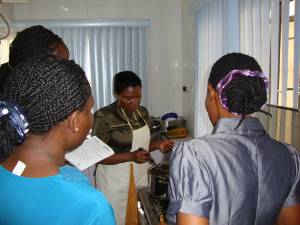How cooking helps to foster good physical and mental health
CeliaPenny Moses-Nagbiku (ROHP / RNCP, MS, BSc)
Registered Orthomolecular Health Practitioner & Nutritional Consulting Practitioner
Nutrition Educator / Geneticist
CeliaPenny Foundation for the prevention of malnutrition in Africa
Unlike the hunger pangs that compel an individual to look for food at all cost, cellular nutrient deficiencies in the human body resulting from insufficient intake or malabsorption of nutrients, do not elicit clear warning signals such as “feed me or I die”. The absence of clear alarm system that warns an individual against imminent micronutrient scarcity is the basis for cellular nutrient starvation, and consequently, various health complaints. The primary focus of Eating for Health is the provision of an optimal level of nutrients to prevent nutrient scarcity and foster physical and mental health. In light of the forementioned, it is important to apply cooking techniques that do not lead to unnecessary nutrient loss.
Physical Health
Physical wellbeing is defined by Seaward1 as “optimal functioning of all body systems” (e.g. cardiovascular, immune, musculoskeletal, endocrine, nervous, reproductive, digestive, pulmonary systems). An unhealthy constitution is characterized by an energy and biochemical imbalance, which can often be attributed to an unhealthy lifestyle (unbalanced diet, sedentary occupation, lack of exercise and faulty posture). A disturbance of the energy homeostasis of the body can manifest itself via numerous symptoms such as apathy, sluggishness, skin problems, frequent tiredness, poor vision, stunted or slow bone growth and susceptibility to common infections.
What is cooking?
Cooking, as defined by the Encarta dictionary, is “the process or activity of preparing food for eating”2. It encompasses boiling, poaching, baking, frying, roasting, toasting, grilling, braising, stewing and so on. Cooking processes can exterminate disease causing bacteria and increase palatability. If meat is cooked properly, the organisms that thrive on raw meat are killed. Though the process of food preparation can lead to a loss of nutrients, it can convert the composition of some nutritional products and make them more bio-available for absorption and easier digestion. For example, boiled eggs harden and proteins in meats and poultry become firmer
Table 1. Nutrients needed for physical and mental health and their sources
Nutrient
Function
Sources
Vitamin A
Infection resistance
Mustard and dark leafy greens
Vitamin B1 (thiamine)
Heart, nerves and mental function
Oats, brown rice, soy milk, peppers, cabbage, sesame seeds, tuna
B3 (niacin)
Lower cardiovascular risks
Brown rice, broccoli, mushrooms, peanuts, beef liver, tuna, sunflower seeds
B5
Formation of antibodies
Oats, brown rice, yoghurt, watermelon, lemons, broccoli, peas, carrots, avocados, sweet potatoes, mushrooms, broad beans
B6
White blood cell function
Brown rice, tuna, avocado, peppers, soy beans
B12
Sound metabolism and bone marrow health
Turkey, salmon, tuna, shrimp, crab, clams, cottage cheese, low fat yogurt, poached eggs and milk
Vitamin C
A water soluble antioxidant that can stimulate collagen formation
Red pepper, sprouts, cauliflower, celery, cabbage, watercress, oranges, papaya, cranberries, pineapple
Vitamin D
Resistance to infection and thyroid function
Fish oil
Vitamin E
A fat soluble antioxidant
Avocado, peanuts, spinach, and beet greens
Folic Acid
Immune system
Lettuce, beetroot, cabbage, avocados, shrimp, turkey, sesame seeds, peanuts, lentils, chickpeas, and oranges
GABA (gamma-aminobutyric acid)
Mental health
Oats, rice and quinoa
Magnesium
Energy
Leafy greens like spinach and cabbage, avocado, peppers, peanuts, pumpkin, plain yogurt, beans, oranges, raisins and chocolate
Omega 3 fatty acids
Mental health
Sardines, turkey breast, shrimp, garlic, spinach, soy beans, oats, brown rice, cheese and sunflower seeds
Selenium
Mood
Lima beans, brown rice, sesame seeds and cabbage
Tyrosine
Production of neurotransmitters
Tuna, beef liver, avocados, soy sauce, yeast extract, bananas, raisins and tomatoes
Zinc
Immune system
Shrimp, fortified breakfast cereal, cashews, cheddar cheese, low fat yogurt, chickpeas, lentils, chicken (dark meat), beef mince
Tryptophan
Production of serotonin
Skinless turkey, plain yogurt, milk, eggs, cottage cheese, peanuts/soy nuts, pumpkin, sesame seeds, soy milk or spinach and cabbage
Cooking and protein digestibility
Foods that benefit from cooking include high protein plant foods like African yam and soybeans. According to Ene-Obong & Obizoba3, “soaking and cooking African yam beans improves their protein digestibility”.
Heat, whether from cooking or sprouting contributes to the destruction of anti-nutrients. Anti-nutrients are naturally present to prevent the breakdown of proteins into smaller components, but are degraded with a rise in temperature. In addition, proteins like collagen found in cartilage and connective tissues of meats, can be broken down when cooked in moist heat.
By increasing the temperature to above 70°C (158°F) one can gelatinize starch and improve its digestibility. On the other hand, Englyst (1985), also cited in BeyondVeg.com4 that “some resistant, or indigestible, starch is formed by cooking”. These resistant starches are present in small quantities in rolled and steamed oats. Uncooked oats however do not contain resistant starch. In other words, we absorb and utilize less starch from oats when they are cooked.
Effect of heat on minerals
Cooking is not necessarily linked to nutrient loss, whereas high temperatures may affect vitamins, it does not lead to mineral loss. Nonetheless, whenever possible, it is desirable to eat fruits and leafy vegetables raw or to cook them as little as possible.
Vitamin loss depends on various factors, ranging from solubility in water, exposure to air, light, acid and alkaline environments, storage and exposure to heat. Not all vitamin depletions have a detrimental effect on health and certain vitamins become abundantly available in cooking, such as Pantothenic acid- B5. The vitamins whose deficiencies are worrisome are: Vitamin A, D, E (which are fat soluble), thiamine -B1, riboflavin-B2, niacin –B3, folate –B9, and cobalamin -B12, (which are water soluble).
To preserve vitamin loss, it is recommended to use fresh foods and steam leafy vegetables. Furthermore, one should avoid the peeling of vegetables, lengthy soaking of grains or seeds and prolonged cooking times.


- Vitamin A is relatively stable and not easily affected by exposure to heat.
- Thiamine is influenced by temperatures above 100°C (212°F), while heat doesn’t lead to riboflavin- B2 and biotin- B7 loss4.
- Oil soluble vitamin D, E, K and water soluble B12 are not affected by warm conditions.
- In general, cooking, with the exception of steaming, causes loss of vitamin C. Prolonged cooking can cause a 15-55% vitamin C loss5.
- Niacin – B3 and folate – B9 are destroyed at high temperatures.
- The effect of heat on pyridoxine- B6 is not clear.
Conclusion
Armed with the above information, we can understand the necessity of choosing nutrient dense foods for good physical and mental health and to prepare them wisely. All of the aforementioned nutrients are found in a nutrient dense diet. Therefore, meals have to be properly balanced during preparation. Foods should be eaten in a way that would enable absorption of nutrients. Vitamins that are affected by heat are consequently affected by the various cooking methods. In Nigeria, we boil our meat, fry it and stew it before eating. To preserve nutrient loss, it would be beneficial to use fresh foods, steam leafy vegetables instead of boiling and to avoid long cooking times.
ABOUT THE AUTHOR
Celia Penny Moses-Nagbiku is the President of the CeliaPenny Foundation for the Prevention of Malnutrition in Africa and the founder of CeliaPenny Gene-Nutrition Solutions in Lagos, Nigeria. She is currently a coordinator of the ‘Movement of Life’ in Nigeria. You can learn more about her initiatives on the following website: www.celiapennyfoundation.org
References
- Seaward, BL. Essentials of Managing Stress. 2nd ed. Burlington: Jones and Barlett’s Publishers; 2011:298.
- Microsoft® Encarta, Microsoft Corporation 2009.
- Ene-Obong, HN and Obizoba, IC. Effect of domestic processing on the cooking time, nutrients, anti-nutrients and in vitro Protein digestibility of the African yam beans (Sphenostylis stenocarpa). Plant Foods for Human Nutrition. 1996; 49(1): 43-52.
- BeyondVeg.com Published in 2012.
- Rath, M (2014). The Barletta Declaration. Making Natural Preventive Health a Human Right. Barletta, 2014; 11.


